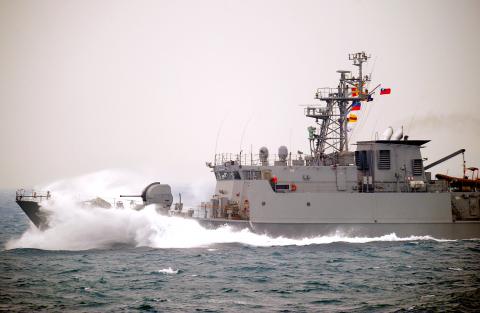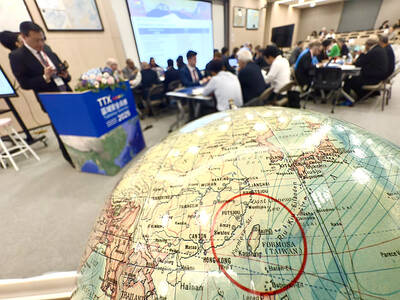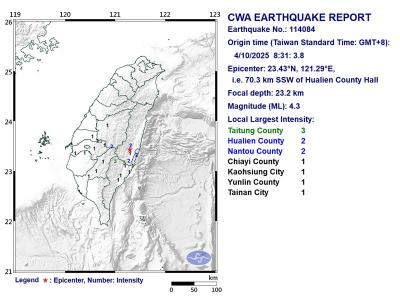The military has begun modifying its fleet of domestically made Ching Chiang-class patrol boats by equipping them with Hsiung Feng III (HF-3) ramjet-powered supersonic anti-ship missiles to counter large surface ships in the Taiwan Strait.
Developed by China Shipbuilding Corp — now known as CSBC Corp, Taiwan — in the 1990s, a total of 11 of the 500 tonne coastal patrol vessels entered service with the navy in 1999 and 2000. The ships were initially equipped with four HF-1 surface-to-surface missiles, one 40mm anti-aircraft gun and one 20mm gun.
In May last year, the Ministry of National Defense unveiled plans to outfit the navy’s eight Cheng Kung-class frigates and a number of Ching Chiang-class vessels with the HF-3, Taiwan’s “aircraft carrier killer” cruise missile developed by the Chungshan Institute of Science and Technology.

Photo: Chang Chung-yi, Taipei Times
Reports yesterday said modification work had begun on seven of the patrol boats, each of which is to be equipped with four HF-3 launchers, and that five Cheng Kung-class frigates had been outfitted with the missile so far as part of a NT$12 billion (US$406 million) program to arm the navy with 120 HF-3s.
A new 500 tonne radar-evasive fast attack corvette, currently at development stage under a project codenamed “Hsun Hai,” or “Swift Sea,” is also expected to be outfitted with eight HF-3s and HF-2s.
Light missile boats like the Ching Chiang, Hsun Hai and the 170 tonne Kuang Hua VI-class vessels launched in recent years are part of ongoing efforts to create an asymmetrical capability to counter China’s increasingly powerful navy. Relatively slow destroyers and frigates with heavy displacement, including aircraft carriers, are seen as particularly vulnerable to asymmetrical strategies.
Although ministry sources have confirmed plans to deploy land-based HF-3s on the west and east coasts of Taiwan, the ministry denied reports last month that an extended range variant of the missile, currently at 300km, was under development.
A longer-range HF-3 would allow Taiwan to deploy the missiles on the eastern coast and aim them at the Taiwan Strait while using mountainous geography, such as that found in Hualien, as cover from missile attacks by China, thus limiting exposure of the launchers.
The HF-3 entered production in 2010. At least 250 are believed to be in service.

Taiwan is stepping up plans to create self-sufficient supply chains for combat drones and increase foreign orders from the US to counter China’s numerical superiority, a defense official said on Saturday. Commenting on condition of anonymity, the official said the nation’s armed forces are in agreement with US Admiral Samuel Paparo’s assessment that Taiwan’s military must be prepared to turn the nation’s waters into a “hellscape” for the Chinese People’s Liberation Army (PLA). Paparo, the commander of the US Indo-Pacific Command, reiterated the concept during a Congressional hearing in Washington on Wednesday. He first coined the term in a security conference last

DEFENSE: The National Security Bureau promised to expand communication and intelligence cooperation with global partners and enhance its strategic analytical skills China has not only increased military exercises and “gray zone” tactics against Taiwan this year, but also continues to recruit military personnel for espionage, the National Security Bureau (NSB) said yesterday in a report to the Legislative Yuan. The bureau submitted the report ahead of NSB Director-General Tsai Ming-yen’s (蔡明彥) appearance before the Foreign and National Defense Committee today. Last year, the Chinese People’s Liberation Army (PLA) conducted “Joint Sword-2024A and B” military exercises targeting Taiwan and carried out 40 combat readiness patrols, the bureau said. In addition, Chinese military aircraft entered Taiwan’s airspace 3,070 times last year, up about

A magnitude 4.3 earthquake struck eastern Taiwan's Hualien County at 8:31am today, according to the Central Weather Administration (CWA). The epicenter of the temblor was located in Hualien County, about 70.3 kilometers south southwest of Hualien County Hall, at a depth of 23.2km, according to the administration. There were no immediate reports of damage resulting from the quake. The earthquake's intensity, which gauges the actual effect of a temblor, was highest in Taitung County, where it measured 3 on Taiwan's 7-tier intensity scale. The quake also measured an intensity of 2 in Hualien and Nantou counties, the CWA said.

The Overseas Community Affairs Council (OCAC) yesterday announced a fundraising campaign to support survivors of the magnitude 7.7 earthquake that struck Myanmar on March 28, with two prayer events scheduled in Taipei and Taichung later this week. “While initial rescue operations have concluded [in Myanmar], many survivors are now facing increasingly difficult living conditions,” OCAC Minister Hsu Chia-ching (徐佳青) told a news conference in Taipei. The fundraising campaign, which runs through May 31, is focused on supporting the reconstruction of damaged overseas compatriot schools, assisting students from Myanmar in Taiwan, and providing essential items, such as drinking water, food and medical supplies,